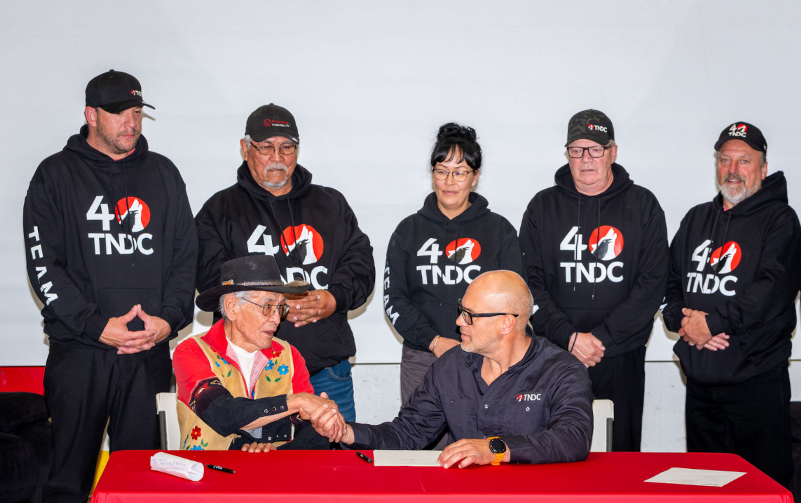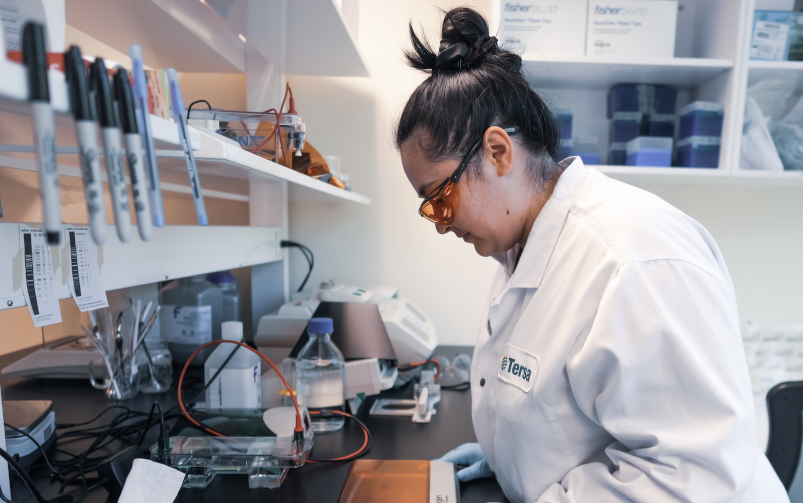Charlie Arngak, former mayor of the Inuit community Kangiqsujuaq, played an active role in the development of the 1995 Raglan Agreement, the spirit of which guides the relationship between Glencore and its Indigenous partners in Nunavik. Photo: Cedric Gallant
This was one of our favourite stories of the year. To see the full list, check out our Editors' Picks 2025.
In the early 1990s, Charlie Arngak, the then mayor of Kangiqsujuaq, an Inuit community in Nunavik, Quebec, took a stance for his people by travelling to Toronto to meet the CEO of Falconbridge, a Canadian mining company that was looking into mining nickel in the region at the time. What came of that initiative was a groundbreaking agreement that, 30 years later, remains world-class at improving relationships between mining corporations and Indigenous communities.
“I had to stand up for the people of my community, and for the people of Nunavik,” said Arngak in a speech he made at the Raglan mine in 2024, of his meeting with Falconbridge CEO, Thomas Pugsley, who had not expected the mayor’s visit. But, “we had a hard talk, and he realized that I was serious,” added Arngak.
Arngak took it upon himself to make sure that Falconbridge would sit at the table with Inuit members to negotiate an agreement before mining the nickel could take place on the land they love.
What came of that initiative was years of sometimes contentious negotiations, which concluded with the signing of the 1995 Raglan Agreement, the first impact benefits agreement (IBA) of its kind in Canada.
“It was a tough negotiation,” Arngak said. “Sometimes we had to get out of the room because it was too frustrating. But in the end, we always got back and started again.”
The goal was to avoid repeating what had happened with Asbestos Hill, a mine near Kangiqsujuaq that was abruptly abandoned in the 1980s, leaving lasting economic, environmental and health consequences for the community.
Thirty years later, the Raglan Agreement has achieved far more than what it had initially set out to do; it became a tool for the Inuit of Nunavik to take power over the environmental and socio-economic impacts of the mine, and to ensure their expertise in the mining sector for future generations.
Economic reconciliation, from paper to reality
“What was written is white on black, black on white,” said Raglan mine vice-president Jean-François Verret in an interview with CIM Magazine. “We need to understand, generation after generation, what the meaning really was behind the agreement.”
He called it the “spirit of the Raglan Agreement,” which is about proactively building trust through economic reconciliation between the mining company and Nunavik communities.
On paper, the IBA provides the 14 Nunavik communities with profit sharing. Since its creation, Raglan has distributed $250 million to the Inuit inhabitants of Nunavik—known as Nunavimmiut—through profit sharing alone.
The agreement also mandates that at least 20 per cent of the staff at the mine be Inuit, with an average annual payroll of $18 million specifically for Nunavik employees.
The company has also spent $600,000 in scholarships for Nunavimmiut who wished to study in a specialized field in a school down south, as well as around $1 million in community support projects.
To take it a step further, Raglan created the Tamatumani program in 2008. Under it are multiple programs that specialize in training and retaining Inuit employees.
One of those programs is the Stope School, where Inuit apprentices with no mining experience can train at the mine. If they successfully complete the training, apprentices are accredited by the Government of Quebec for their work.
Another economic contribution Raglan makes to the community is through its partnerships with Inuit corporations. Verret said that 25 per cent of the mine’s goods and services are provided by Inuit-owned businesses.
Through those partnerships, money has indirectly trickled down into tangible infrastructure and socio-economic projects within the communities.
Nuvumiut Developments, owned by the Salluit Qaqqalik Landholding Corporation and the Kangiqsujuaq Nunaturlik Landholding Corporation, was created in 1996 in the wake of the Raglan Agreement. It initially explored joint venture opportunities to supply goods and services to Raglan, but now it also works with Canadian Royalties—which operates a neighbouring nickel mine—while also expanding into human resources management, specializing in Inuit staff recruitment in Nunavik.
“We try to take care of our people’s needs,” said Lukasi Pilurtuut, Kangiqsujuaq’s general manager at Nuvumiut Developments, in an interview with CIM Magazine. With the profits that Nuvumiut Developments has made, it has been able to reinvest in the community.
The fruits of those investments can be seen in the Auberge Kangiqsujuaq, a 14-bedroom hotel in the heart of the community. An elders’ home was built to make sure its eldest and wisest people remain home, even if they need special care. A family house was built to give shelter to mothers and children escaping from domestic violence.
“We are trying to use the money we make to create more infrastructure in our community,” explained Pilurtuut, adding that Salluit, the partner community, also reinvests its profits in a similar way.
Raglan also entrusted Inuit corporations with large-scale contracts for its Anuri mine, a major expansion project, which was completed in early 2024 and has added an estimated 25 years to Raglan’s operations.
A contract for the Anuri mine’s earthworks was awarded to a joint partnership between Kiewit and Nuvumiut Developments, another for underground development was given to a similar partnership between The Redpath Group and Nuvumiut Developments, while the joint venture between Groupe Promec and JNA Nunavik Consulting had the task of building the surface infrastructure.
“Name me one project that was built like that, that ensures a future of 25 years; there are none,” said Verret.
He believes that since the Anuri expansion was completed successfully, this model of project development in partnership with local communities should be replicated.
“We have been here for 30 years, and we believe we will be here for another 25 years,” he added. “This is a whole lifetime, it is long, and that is why we need to invest in communities, invest in relationships, invest in respect. It just makes sense for a business relationship that could last 50, 60 or 70 years.”
Closing the mine, for the land and the people
The Raglan mine is expected to remain operational until at least 2040. In 2017, negotiators of the Raglan Agreement reconvened to add additional measures to the agreement. One of those measures was the creation of the mine’s closure subcommittee.
Memorial University professor and non-partisan expert member of the closure subcommittee Arn Keeling said in an interview with CIM Magazine that the creation of the subcommittee was sparked by Inuit being concerned about the management of tailings in the future, with most community members and leaders being unaware or uninvolved in the mine’s closure plans.
The dialogue between Raglan and the Inuit has been flowing at the quarterly subcommittee meetings, with more and more complex questions being asked in the process. “As soon as we started pulling the threads on the closure plan, we started to find all these questions that we need to look into,” said Keeling.
Questions about climate change started to come up. How will environmental management change in a world that might be three degrees warmer? “Suddenly, we are not planning based on today’s world, but we are planning on a future forecast of the world,” added Keeling.
Socio-economic questions also became part of the discussions, including concerns about what Nunavik’s economy would look like after the mine closes and what would happen to community members formerly employed at Raglan.
“We don’t have the answers yet, we are only starting now to do more community engagement, to think about a post-mining future,” said Keeling. But with Raglan’s life expected to extend to at least 2040, the subcommittee has time to break down these questions and find solutions for them.
Pilurtuut believes that with corporations such as Nuvumiut Developments, Inuit are growing to become experts in the field of mining in Nunavik, expertise they can bring when other mining opportunities come to the region.
“There are a lot of mining companies that are doing activities in our area. I think Nuvumiut Developments will be much bigger than what it is now,” said Pilurtuut, who hopes more Inuit will continue to become more active in these projects.
To Keeling, the closure subcommittee holds an important role in the mine’s life, as it discusses its longest cycle. “The earlier you think about the closure, the better,” he said, adding that the right time to think about mine closure is before the mining begins.
One of the early goals of this subcommittee was to be at the leading edge of best practices in Quebec, Canada and internationally. “We feel like we are doing that,” added Keeling.
Creating a lasting relationship
Keeling believes that, for the rest of the Canadian industry, one of the lessons learned from Raglan’s relationship with the Inuit is the duty to consult. It has placed the relationship on a stronger footing than what relationships were in the past.
“I can’t say that everything has been perfect,” admitted Verret. “But it is part of our foundation, we are investing time.”
At the moment, Raglan is facing difficult competition in the nickel industry, with the China-backed Indonesian mines taking over the market rapidly.
Verret remains dedicated to Raglan’s philosophy. “No matter what happens in the market, we will never deviate from the foundation of our strategy, which is respect, the spirit of the Raglan Agreement,” he said.




